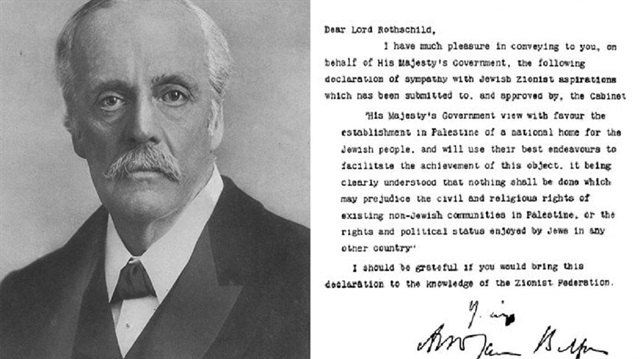

The Balfour Declaration
The Balfour Declaration, only a 67-word letter, caused deep suffering around the world
On its 100th anniversary, the Balfour Declaration is being criticized by Palestine and the international community. The document is interpreted as the source of the conflicts in Palestine, which still demands an apology for this declaration of shame.
What is the Balfour Declaration?
During World War I, on Nov. 2, 1917, British Foreign Secretary Arthur Balfour sent a letter to Lord Rothschild, one of the leaders of the international Zionism movement. The letter, known as the “Balfour Declaration,” said the British government would support them in the establishment of a Jewish state in Palestinian territory. The letter reads:
Dear Lord Rothschild,
I have much pleasure in conveying to you. On behalf of His Majesty's Government, the following declaration of sympathy with Jewish Zionist aspirations which has been submitted to, and approved by, the Cabinet
His Majesty's Government view with favor the establishment in Palestine of a national home for the Jewish people, and will use their best endeavors to facilitate the achievement of this object, it being clearly understood that nothing shall be done which may prejudice the civil and religious rights of existing non-Jewish communities in Palestine or the rights and political status enjoyed by Jews in any other country.
I should be grateful if you would bring this declaration to the knowledge of the Zionist Federation.
Yours,
Arthur James Balfour

What was the objective of the British government?
In 1917, when the letter was written, 600,000 Muslims and Christian Arabs lived in Palestine, while only 60,000 Jews resided in the country. This letter played an important role in the establishment of a Jewish state in Palestinian territory, where the majority of its population was Muslim.
The main objective was the occupation of Palestine. The then British government, whose prime minister was David Lloyd George, wrote this declaration as they aimed to enhance Zionism and benefit from this power. This was only possible by protecting their interests in the Suez Canal. Palestine has strategic importance in terms of the Suez Canal. Therefore, the United Kingdom wanted the Jews to rule the region so that it could govern Palestine using them.

What was the reaction of the Ottoman Empire?
The developments during and after the Balfour Declaration caused the Zionists around the world to take side with the Entente Powers, which supported Balfour, particularly Britain and France. The United States also endorsed the declaration and led the way to the establishment of a Jewish state.
The Ottoman Empire was not able to adopt a strong attitude against the declaration, as it was experiencing its downfall. Ottoman Ambassador to Vienna, former Grand Vizier Hüseyin Hilmi Pasha reported to the Ottoman Empire that the U.S. president supported the declaration, and he convinced the British government and proposed that “Jerusalem should be defended at any cost.”

Balfour Declaration: From freedom to captivity
The Balfour Declaration affected the fate of Palestine, the region and the world. Bloodshed, persecution and suffering began in Palestine in 1917, when the declaration was written and led to the Jewish state on Palestinian territory.
Nothing was the same after the Judaization of Jerusalem, the resistance of Palestinians and an-Nakba day, meaning “disaster,” when Israel was established in 1948. Millions of Palestinians were forced to leave their homeland and take refuge in neighboring countries. In Palestine, freedom ended and begun. Welfare in the country anymore; hunger and poverty ruled Palestine.

Millions had to take refuge
According to the Palestinian Central Bureau of Statistics (PCBS), there are 5.9 million Palestinian refugees in the world today. The United Nations Relief and Works Agency for Palestine Refugees in the Near East (UNRWA) states that this number has neared 5 million 300 thousand. Israel continues to Judaize Eastern Jerusalem which it has occupied for 50 years, in spite of the international community’s reactions.
Over 1.5 million Palestinian refugees take shelter in 61 camps located in Gaza, the West Bank, Lebanon, Jordan and Syria. The remaining 3.8 million refugees are scattered around the world.
While the population of Palestinians is 12.4 million, refugees constitute almost half of this number. The width of the area of the camps built by the U.N. for Palestinian refugees remains the same although the population increases.
The refugees in Gaza are faced with a humanitarian crisis due to the embargo imposed by Israel in Gaza since 2006. According to the U.N., 80 percent of the people living in Gaza need of international aid to survive due to poverty and unemployment.
#Balfour Declaration
#Israel
#Palestine
#United Kingdom
#Britain
#United Nations
#United States





